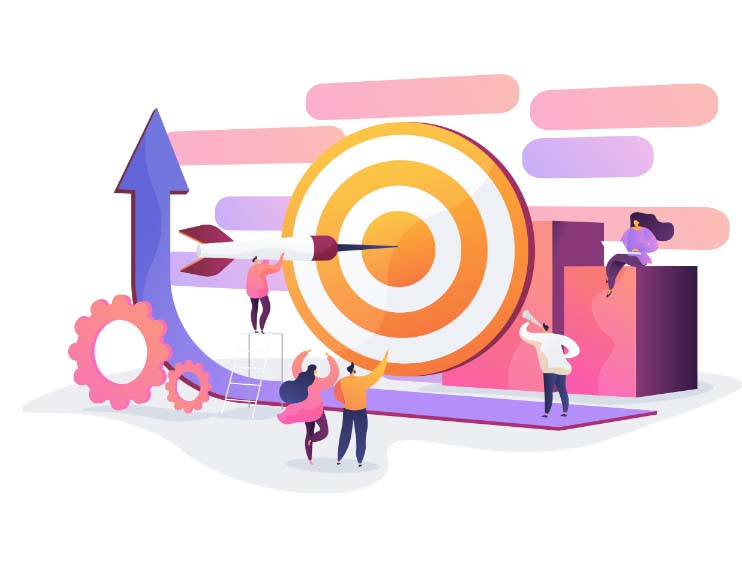We’ll cut to the chase: if you have a website, you likely need SEO. This guide is packed with everything you need to know. Got some time? Settle in for a comprehensive read. Need something specific? Jump straight to it.
Search Engine Optimization (SEO) is a digital marketing practice that improves your website’s visibility in search engine results. When potential customers search for products or services related to your business, SEO helps your website appear as high as possible in the search results.
SEO is not a singular task or the waving of a magic wand. It’s a comprehensive and holistic approach to improving a website and online presence. It involves refining the content and structure of your site and aligning with search engine algorithms to improve your rankings. From keyword research and on-page optimization to technical SEO and link building, SEO encompasses a wide range of strategies that work together to elevate your site’s position in search engine result pages (SERPs).

Why does it matter how high you rank in search results or how well your website runs? The answer is simple: higher rankings and a well-optimized website directly shape your business’s success. Here are ten key reasons why SEO is crucial for your business:
Captures Search Demand: People use search engines like Google to find products, services, and information. SEO helps you outrank the competition and capture this demand, so your website is seen by those looking for what you offer.
Provides Sustainable, Free Traffic: Unlike paid advertising, SEO generates free, passive, and sustainable traffic 24/7. Once your site is well-optimized and you have strong, ongoing SEO practices, your site can continue attracting visitors without any limitations imposed by business hours or time zones.
Serves as Cost-Effective Marketing: After achieving high rankings, maintaining them requires less effort and cost than other marketing methods that demand constant attention and resources, like social media or digital PR.
Provides a Competitive Advantage: If your competitors are likely investing in SEO, you must keep up. If they’re not, you have a golden opportunity to dominate search results and capitalize on available traffic. Tools like Semrush and Ahrefs can help you analyze your competitors’ organic traffic and strategize accordingly.
Builds Brand Awareness: Even if users don’t click on your site, repeatedly seeing your brand in search results builds awareness. Over time, this visibility fosters credibility and trust, making your brand a go-to in your industry.
Targets All Stages of the Buying Journey: SEO allows you to reach prospects at any stage of their buying journey. By optimizing for different keywords–informational, commercial, navigational, and transactional–you can engage potential customers early and guide them through your marketing funnel.
Expands Audience Reach: SEO allows you to target multiple audiences simultaneously based on search intent rather than demographics. This capability broadens your reach and allows you to connect with a range of potential customers.
Supports Other Marketing Endeavors: SEO complements other marketing strategies, particularly Pay-Per-Click (PPC) ads. When your site appears in paid and organic results, you enhance your credibility and increase the likelihood of attracting clicks.
Improves Website Usability: Optimizing for SEO often improves your website’s usability. Factors like site speed, mobile friendliness, and a clean linking structure help with rankings and create a better user experience (UX), leading to higher conversion rates.
Tracks Market Trends: Through keyword research, SEO helps you stay on top of market trends by monitoring your audience’s search activity. This insight can guide your product strategy, marketing campaigns, and overall business decisions.
We all rely on search engines to find everything from quick answers to complex research. Whether you’re searching for a recipe, troubleshooting a problem, or just satisfying curiosity, search engines are our go-to resource. Google stands out as the most widely used, often serving as our first stop on the Internet.
Search engines operate using two main components:
Search Index: A vast digital library that stores information about web pages.
Search Algorithms: Programs that match and rank results from the index based on a user’s search query.
This combination allows search engines to sift through massive amounts of information and bring the most relevant results to your fingertips in seconds.
The process of how search engines work can be divided into three key phases:
Crawling: Web crawlers, or spiders, browse the Internet, visiting and downloading web pages by following links from known pages.
Indexing: The information collected during crawling is processed and added to the search index, where it’s stored for future retrieval.
Ranking: When you conduct a search, the search engine uses its algorithm to rank the relevant results from the index, based on various factors, to deliver the most accurate and helpful answers on the SERP.
In simple terms, when you search for something online, search engines sift through their index to find relevant pages. They then use algorithms to rank these pages, placing the most relevant and high-quality results at the top of the SERP.
The challenge is that search engines try to be secretive about how the algorithms work, leading SEOs to rely on trial and error to understand what works best. That said, the SEO community has gleaned many insights, which is why the Google Algorithm Leak of 2024 was not Earth-shattering.
Google considers several key factors when determining rankings, including:
Page Speed: How quickly your pages load.
Mobile-Friendliness: Optimizing your site for mobile devices.
Backlinks: Links from other websites that point to your site, showing credibility and relevance.
Relevance to Search Intent: How well your content matches what users are seeking.
Freshness: The recency of your content.
HTTPS: Verifying your site is secure with HTTPS encryption.
Intrusive Interstitials: Avoiding pop-up ads or content obstructing the user’s view of the page.
In addition to these factors, Google also personalizes search results based on:
Location: Tailoring results to the user’s geographical area.
Language: Matching content to the user’s preferred language.
Search History: Considering the user’s past search behavior to deliver more relevant results.

So, how does SEO actually work? It’s all about aligning your website and content with what the search engine considers valuable for search results. Essentially, SEO involves creating high-quality, relevant content through a great user experience and convincing Google that your content deserves to rank highly for specific search queries.
Keyword Research: Identifying the terms and phrases your target audience is searching for.
Search Intent: Understanding the purpose behind a user’s query and ensuring your content satisfies that need.
Content Quality: Producing optimized content that demonstrates E-E-A-T (Experience, Expertise, Authoritativeness, and Trustworthiness)
Backlinks: Earning links on respected websites back to your site to boost your site’s credibility.
User Experience: Ensuring your site is fast, easy to navigate, and accessible, providing a seamless experience for visitors.
Technical SEO: Optimizing the behind-the-scenes aspects of your site, such as improving page speed, ensuring mobile friendliness, and fixing any technical issues.
SEO offers many benefits to transform your business’s online presence and success. Here are some of the most significant:

Increases Website Traffic: By optimizing search engines, you can attract a steady stream of organic traffic from people actively looking for the products or services you offer.
Increases Brand Awareness: Appearing at the top of search results keeps your brand in front of potential customers. When your company consistently shows up on searches, you establish yourself as an industry leader and build topical authority.
Provides Customer Insights: SEO offers valuable data about customer preferences and behaviors. You can learn how visitors find your site, where they enter and exit, which pages they spend the most time on, and which topics are gaining or losing popularity.
Improves UX: Good SEO goes hand-in-hand with a better user experience. A well-optimized site is faster, easier to navigate, and more accessible, leading to higher user satisfaction and better conversion rates.
Keeps You Competitive: With SEO tools like Semrush or Ahrefs, you can analyze your competitors’ strategies and identify opportunities to outperform them. Staying competitive in search rankings is crucial to capturing your market share.
Supports Overall Marketing: SEO is the cornerstone of a robust marketing strategy. Excellent UX can increase sales, and high SERP rankings can boost PPC and vice versa.
Welcomed by Consumers: As a form of inbound marketing, SEO is less intrusive than other methods. It caters to people actively searching for your offerings, making it highly effective at driving conversions.
Wins the Long Game: SEO is a long-term investment with growth that compounds over time. While it requires consistent upkeep, and rankings may fluctuate in the short term, SEO helps deliver a positive upward trend in long-term traffic.
Round-the-Clock Performance: SEO works while you sleep. It ensures your website is always ready to attract visitors, regardless of the time of day. With the proper optimizations in place, SEO provides constant value without needing ongoing input that other time-bound marketing campaigns require (e.g., keeping up with the continuous demand for new social media posts).
SEO encompasses many strategies to improve website visibility and rankings. These strategies can be grouped into three main categories: On-Page SEO, Off-Page SEO, and Technical SEO. Each type of SEO focuses on different aspects of your website and online presence, but they all work together to enhance your search engine performance.
On-page SEO focuses on optimizing on-page elements to align with search engine algorithms and user intent. This type of SEO involves creating high-quality, relevant content and ensuring each page is structured so search engines can easily understand. Key activities include:
Keyword Research: Identifying the right keywords to target based on what your audience is searching for.
Optimizing Page Headers, Title Tags, and Meta Descriptions: Ensuring these elements are aligned with targeted keywords to improve relevance.
Content Updates: Keeping product descriptions rich and up to date, adding fresh content to your blog, and updating old articles or service pages.
HTML Tags: Structuring content using proper HTML tags.
Image Optimization: Optimizing images for faster load times and viewing quality.
Off-page SEO focuses on factors outside your website that influence ranking in search results. The primary goal is to build your website’s authority and credibility through activities like:
Building Backlinks: Acquiring high-quality backlinks from reputable websites that let search engines know your site is trustworthy and authoritative.
Optimizing Your Google Business Profile: Ensuring your business profile is complete and optimized to improve local search visibility.
Content Marketing: Attracting natural backlinks through guest blogging, industry insights, and opinion pieces.
Online PR: Publishing press releases, forming influencer partnerships, and conducting other forms of PR to improve your brand’s reputation.

Technical SEO involves optimizing the behind-the-scenes elements of your website to help search engines crawl, understand, and index your content. This includes:
Page Speed Improvements: Ensuring your website loads quickly to enhance user experience and meet search engine requirements.
Fixing Errors: Addressing issues found in website crawls and audits, such as indexing or URL problems.
Updating Security Status: Implementing HTTPS and other security measures to protect your site and its users.
Setting Up Sitemaps: Creating and submitting a sitemap in Google Search Console to help search engines navigate your site.
Eliminating Duplicate Content: Ensuring that each piece of content on your site is unique and fully optimized.

Search engine marketing comprises two key strategies: SEO and Pay-Per-Click (PPC) advertising. Both of these strategies have unique strengths and can be powerful tools, but they operate in fundamentally different ways.
As we have discussed, SEO focuses on improving your online presence to naturally appear higher in search engine results without paying for placement. While there are costs associated with effective SEO–such as hiring expert help, subscribing to SEO software, or investing in content creation–the traffic you generate from successful SEO efforts is essentially free.
PPC, on the other hand, is a form of paid advertising where you pay for clicks. While there are different types of PPC, with search engine PPC, you bid for your website’s placement at the top of SERPs. These are the sponsored results you often see above the organic listings. PPC allows you to buy immediate visibility, making it a fast-track option for driving traffic to your site.

Here’s how PPC advertising on Google typically works:
Keyword Research: Like SEO, PPC starts with identifying the keywords your potential customers are searching for.
Ad Creation: For PPC to work, the ads must be compelling and relevant. Google assigns a Quality Score to your ads based on the likelihood that viewers will click on the ad, how closely your ad matches search intent, and how pertinent your landing page is to the viewers. A higher Quality Score means your ads are shown more and often at a lower cost per click.
Bid Setting: You set a bid based on how much you’re willing to pay for each click on your ad. The cost per click varies depending on the keyword’s competitiveness. If your competitors bid higher and have equally relevant ads, Google might show their ads instead of yours.
Audience targeting: You decide who sees your ads based on factors like location, demographics, and interests.
One of the main advantages of PPC is the speed of results. While SEO can take months to build up, PPC campaigns can start driving traffic within minutes of launching.
While strategy can differ from brand to brand, many companies benefit from using both SEO and PPC; here’s how:
PPC ads can help boost SEO rankings.
You can use PPC campaigns to test keyword strategies before implementing them in SEO.
High organic SEO rankings and PPC ads can increase brand awareness and credibility.
Customers who did not convert through SEO strategies might convert with targeted, personalized PPC ads and vice versa.
Search Engine Marketing (SEM) is an umbrella term encompassing all strategies used to increase traffic and visibility in search engines. This broad scope includes SEO and PPC. In other words, SEO and PPC are both types of SEM.
SEO excels in building long-term value and authority, particularly with keywords that attract users in the research or learning phase.
PPC is most effective for high-competition, high-intent keywords where organic ranking is difficult. It allows you to instantly appear in front of potential customers, making it a great tool for testing and optimizing conversion strategies.
SEM, or both SEO and PPC, is beneficial for ad-heavy keywords—terms that trigger many ads in search results. In these cases, organic results are often pushed further down the page. SEM allows you to capture traffic from the high-visibility paid spots while also working to rank for more specific, less competitive variations of the keyword.
As discussed extensively, SEO is a comprehensive, long-term strategy focused on optimizing individual web pages and content to rank higher in SERPs. It involves various techniques, including keyword research, on-page optimizations, content creation, link building, and technical improvements, all of which aim to improve a website’s visibility and relevance over time.
In contrast, programmatic SEO uses automation to quickly create large numbers of web pages, each targeting specific keywords or keyword variations. These pages are generated from a template and populated with data from a database. Because of the automation, programmatic SEO is ideal for businesses looking to scale rapidly by targeting long-tail keywords, location-specific queries, or any niche terms that might not be feasible to address manually.
However, while programmatic SEO offers significant advantages in speed and scalability, it comes with potential risks. If the content on these automatically generated pages is thin, repetitive, or lacking in value, users and search engines can perceive it as spam. Google rewards high-quality, user-friendly content and penalizes spam.
To succeed with programmatic SEO, each generated page must provide unique, valuable, and relevant content. When done well, programmatic SEO is a powerful tool, especially for targeting low-competition keywords or specific niches that might otherwise be overlooked.
Both SEO and programmatic SEO drive organic traffic to your website, but they achieve this in very different ways.

When compared to print advertising, the differences are striking. SEO offers a global, 24/7 presence, driving free, organic traffic to your website. The reach is virtually unlimited, and your content is available around the clock.
Print ads, on the other hand, come with inherent limitations. Whether it’s newspaper ads, direct mail, or billboards, print marketing involves a direct cost and typically targets a limited geographic area. Moreover, print advertising is often perceived as intrusive, junk, or spam. Many people quickly discard direct mail without a second thought, and magazine or newspaper ads are frequently ignored—or missed entirely by those who prefer digital media over print.
In contrast, good SEO is not only welcome but expected. People intentionally seek out the information SEO helps surface, making it a more user-friendly and consumer-centered marketing tool. While print ads have their place in specific strategies, SEO offers a far more versatile, cost-effective, and far-reaching approach.

To develop a successful SEO strategy, it’s essential to focus on several key components that work together to enhance your website’s visibility, drive organic traffic, and improve overall search engine rankings.
Benchmark Current SEO Stats: A successful SEO strategy begins with evaluating where your website currently stands. Audit your site with a tool such as Screaming Frog to identify any technical issues that may be present. Then, gather data on your organic traffic to see how many visitors are coming to your site through unpaid search. Analyze keyword rankings to identify which keywords you rank for, your position in search results, the search volume for each keyword, and how much traffic they generate. Finally, evaluate backlinks by examining the authority score, referring domains, and the number of backlinks pointing to your site. Determining a baseline will help you track progress and set realistic goals.
Research the Competition: The next step is to research your competitors’ actions. Begin by identifying your competition. Look at the valuable keywords they target and audit their backlinks to discover websites linking to them but not to you. By identifying what works and what doesn’t for your competitors, you can find opportunities to improve your SEO efforts.
Set S.M.A.R.T. Goals and KPIs: Establish clear, measurable goals aligning with your business objectives. Focus on metrics such as organic traffic, keyword rankings, and backlinks. Also, consider your average click-through rate (CTR), the percentage of people who click on your site after seeing it in search results.

Audit Your Content: Perform a thorough audit of your existing content to identify areas for improvement. Look for low-performing pages that may need updates or optimization. Consider building out topic clusters, which involve creating a pillar page focused on a broad topic, with a cluster of pages covering related subtopics in more depth. Use internal links between these pages to improve navigation and SEO.
Improve On-Page SEO: Fine-tune your website’s on-page elements to align with SEO best practices. This includes revising title tags, meta descriptions, headings, internal links, and URL slugs to include suitable keywords and communicate what users and search engines need to know.
Identify and Fix Technical SEO Issues: Regularly audit and address issues related to crawling and indexing. Investigate and resolve problems with JavaScript, XML sitemaps, site architecture, URL structure, etc.
Attend to Off-Page SEO: Focus on earning and building high-quality backlinks from reputable sites. Conduct social media marketing to promote your content and cultivate your online presence.
An SEO content strategy is a carefully crafted plan to create, optimize, and distribute high-quality content. The core goal of this strategy is to drive organic traffic by aligning your content with relevant keywords, establishing your website’s authority, and providing valuable information that meets your audience’s needs. This strategy encompasses various types of content, including written articles, images, and videos, all tailored to topics your target audience is actively searching for.
Additionally, content must be created with search engines in mind, meeting the criteria for ranking high in search results.
Google prioritizes quality content, so the goal of a solid SEO content strategy is to satisfy search intent better than your competitors. Here are key ways to enhance your SEO content:
Conduct Original Research: Generate unique insights that can set your content apart from others in your industry.
Provide Extensive Resources: Offer in-depth guides, tutorials, and comprehensive resources that add value to your audience.
Share Expert Opinions and Stories: Include exclusive expert commentary, personal stories, and innovative ideas that reflect your unique perspective.
Present Information Effectively: Ensure your content is well-written, understandable, and easy to navigate.
Cover Topics Comprehensively: Aim to cover each topic thoroughly, addressing all aspects and potential questions your audience might have.
Prioritize E-E-A-T: In your SEO content strategy, prioritize Experience, Expertise, Authoritativeness, and Trustworthiness (E-E-A-T). These are the pillars that Google uses to evaluate the quality of your content and determine its ranking potential.

Research the Competition: The next step is to research your competitors’ actions. Begin by identifying your competition. Look at the valuable keywords they target and audit their backlinks to discover websites linking to them but not to you. By identifying what works and what doesn’t for your competitors, you can find opportunities to improve your SEO efforts.
Set S.M.A.R.T. Goals and KPIs: Establish clear, measurable goals aligning with your business objectives. Focus on metrics such as organic traffic, keyword rankings, and backlinks. Also, consider your average click-through rate (CTR), the percentage of people who click on your site after seeing it in search results.

SEO takes many forms, and the specific strategies needed can vary depending on the existing state of a website. Here are some case studies of SEO marketing efforts and how they transformed the performance of established businesses:
Ensuring your site is properly indexed is crucial, and unfortunately, indexing issues can be easy to miss. For example, a global leader in roofing materials experienced a steep drop in traffic after an accidental “noindex” tag was applied to their entire site. Despite their best efforts, they could not identify the problem. After a strategy session with Cadence, the issue was quickly spotted and resolved, leading to a rapid recovery in traffic. While SEO solutions aren’t always this straightforward, addressing technical SEO issues can sometimes yield immediate benefits.
Site migrations can lead to significant headaches if not handled carefully. A garden center faced a situation where a faulty site migration resulted in numerous broken URLs. These broken links were not only frustrating to users but also detrimental to SEO. The garden center hired Cadence, who identified and fixed these issues by recreating, republishing, and redirecting the URLs. These repairs allowed users and search engines to access content seamlessly and set a solid foundation for future SEO efforts.
A well-established geospatial software company needed their website to match the caliber of their business. During an initial audit, Cadence found that their URL taxonomy was disorganized, affecting their SEO performance. By creating a more structured site architecture, Cadence helped Google better recognize which pages were most important, improving rankings for the key pages.
On-page SEO elements like meta tags, headings, and internal links are essential for communicating the relevance of your content to search engines. Cadence helps the document processing service provider (mentioned above) by updating these elements with the right keywords, which improved their site visibility.
Similarly, for the garden center, Cadence ensured that every page adhered to SEO best practices by fixing meta tags and headers and adding internal links to key pages. These steps improved SEO performance and the overall user experience.
Backlinks are a critical component of off-page SEO. Cadence helped the document processing service provider by securing high-quality backlinks from authoritative industry sources. These backlinks drove direct traffic to the client’s website and proved their credibility in the eyes of search engines.
The cost of investing in SEO can vary widely depending on your business’s needs and the approach you choose. Here’s a breakdown of the different options available.
If you’re considering a do-it-yourself approach, prepare to invest time and effort into learning the ins and outs of SEO. While this option is the least expensive in direct costs, it requires significant time to study through free online resources like blogs, videos, and courses, plus a lot of trial and error. The costs here are more about time and potentially some frustration as you navigate the learning curve.
Building an in-house team gives you complete control over your SEO strategy, but it requires a significant investment in hiring and training staff. This approach is best suited for larger businesses with ongoing SEO needs. Salaries for SEO professionals vary, with entry-level positions starting around $50,000 annually and senior roles potentially exceeding $100,000 annually. In addition to salaries, you’ll also need to budget for tools, software, and ongoing education.
For businesses that want to bring in expert help selectively, hiring freelancers can be a reasonable solution. Freelancers typically specialize in specific areas of SEO, such as content creation, link building, or technical SEO. Costs can vary significantly, typically ranging from $50 to $300 per hour, depending on the freelancer’s experience and the complexity of the project.
Hiring a full-service SEO agency is typically a significant investment, but it also provides the most comprehensive support. Agencies offer a team of experts who manage all aspects of your SEO, from strategy and content creation to technical SEO and analytics. Costs can range from $1,500 to $10,000 per month or more, depending on the agency and the scope of work. While many agencies require a long-term commitment, Cadence does not.


SEO can be complex and often raises many questions, especially for those new to digital marketing or looking to improve their website performance. Below, we address some of the most frequently asked questions about SEO.
Yes, you can do SEO yourself, especially if you run a small to medium-sized website and have the time and willingness to learn. There are plenty of online resources, tools, and communities that can help you get started. However, DIY SEO requires a significant investment of time and usually a high level of frustration tolerance to learn the ropes and stay updated with trends and best practices.
Google’s algorithm is a complex system that retrieves the most relevant data to deliver the best possible results for a search query. The algorithm considers over 200 factors to determine rankings, and the list is constantly updated.
SEO is generally lengthy, typically taking a few months to see noticeable results. However, the timeline can vary depending on the competitiveness of the keywords, the quality of your content, and the overall state of your website. In some cases, such as when technical issues are fixed, results can be seen much faster.
Finding the right keywords is crucial. Start by generating ideas from competitor analysis and your current rankings. Evaluate these keywords based on search volume and difficulty and consider the user’s search intent. Analyze the SERP for related queries. Tools like Ahrefs and Semrush are invaluable for this process.
Finding the right keywords is crucial. Start by generating ideas from competitor analysis and your current rankings. Evaluate these keywords based on search volume and difficulty and consider the user’s search intent. Analyze the SERP for related queries. Tools like Ahrefs and Semrush are invaluable for this process.
Technically, the clicks from organic search are free, but ranking your website to get those clicks requires time, effort, and potential financial investment. You might need to invest in SEO tools, hire experts, or spend significant time learning and implementing SEO strategies yourself.
Yes, SEO is worth it. If potential customers search for your products, solutions, or services, you need SEO to be found and convert browsers into customers.

SEO is a powerful tool that can define your online presence, organic traffic, and business trajectory. Whether you’re just getting started with SEO or looking to refine your existing strategy, having the proper support can make all the difference. At Cadence, we specialize in creating tailored SEO strategies that bring the best results.
Ready to reach your goals? Let’s talk strategy! Book a free consultation with one of our expert team members and experience the difference of having CadenceSEO by your side!
Phone: 888-210-2602
Email: Info@cadenceseo.com
1430 S Boulder Street Unit A, Gilbert , AZ 85296
Unlock the Secrets of SEO Success: Stay Ahead with Our Latest Insights and Updates. Sign up today!
© 2025 CADENCESEO. All Rights Reserved. Privacy Policy
SEO vs. Social Media
SEO and social media marketing are two distinct strategies, but both play crucial roles in a comprehensive digital marketing plan.
In summary, SEO is all about optimizing content, building authority, and improving the overall user experience on your site. On the other hand, social media marketing is centered around building relationships and engaging with your audience on platforms like Facebook, Instagram, X, and LinkedIn.
Compared to SEO, social media is more immediate and dynamic, requiring constant effort to stay relevant. Content posted on social media is quickly overshadowed by new posts, making it necessary to maintain a continual stream of updates to keep your audience engaged.
Social media and SEO can complement one another. For example, a well-optimized blog post can be shared across social media platforms to drive immediate engagement, while SEO efforts promote long-term visibility in search results.
SEO vs. Radio
Of the two, SEO is the most essential tool for most businesses. Any company with a web presence must focus on SEO to ensure they are visible to online searchers. While radio ads can be an excellent way to target niche audiences who listen to specific music, podcasts, or talk shows, they lack the broad, ongoing impact SEO provides.
To be truly effective, radio marketing should be supported by a strong SEO foundation. If someone hears about your business and then searches for related keywords online, they should be able to find you easily. If your SEO isn’t up to par, the impact of radio ads is greatly diminished.